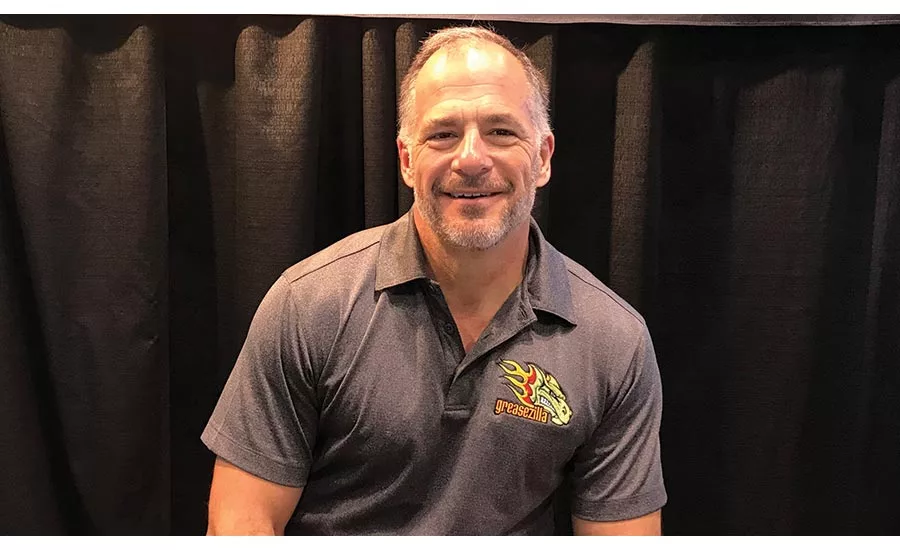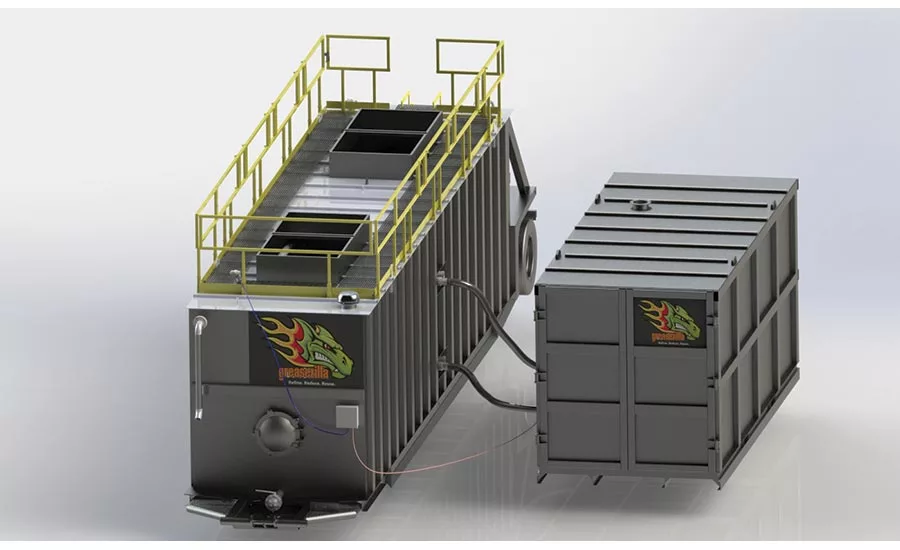Engineering R&D
Separate fats, oils and grease at your facility
Device generates saleable biofuel and water clean enough to go to the local POTW


Greasezilla is a modular FOG separation system that is self-powered and generates saleable biofuel and water clean enough to go to the local POTW.
Photo courtesy of Downey Ridge Environmental Co.
FOG (fats, oil and grease) waste clogging your drainage systems is a problem if you process any kind of protein/food product where FOG is a byproduct. But if you’re successfully collecting it, you may only have two choices in getting rid of the stuff—because your small town publicly owned treatment works (POTW) most likely doesn’t want it either as it can’t expediently process large quantities of FOG. That leaves you collecting and having unprocessed FOG hauled to other third-party locations for processing—or you may now be able to process it on-site, especially if you already have an on-site wastewater pre/treatment system.
If you have enough FOG, you can process it into biofuel to run the FOG conversion process and potentially have enough left over to help fuel your boilers. Or you can sell the excess biofuel. Downey Ridge Environmental Co., developer of Greasezilla, has come up with a FOG separation system that can be implemented at food plants.
I asked Ron Crosier, president of Downey Ridge, to fill us in on who might use Greasezilla and how it works.
FE: Downey Ridge has typically served large-scale, city POTWs, correct? How long has Downey Ridge been in business?
Ron Crosier: We’ve been in business for 10 years but started as the waste treatment arm of Crosier’s Sanitation Service, a waste hauling company. It was two years later that we began selling Greasezilla to friends in the industry. Our Greasezilla client base originated with POTWs and independent haulers.
FE: Is Greasezilla a patented process? Who is the primary inventor/innovator? How long was it in development?
Crosier: Greasezilla is a patented process that I developed over a period of two to three years.
FE: Can you describe how the process works?
Crosier: Collected washdown water, laden with brown grease, enters the system. Greasezilla’s hydronic thermal FOG separation process applies heat to separate the waste into well-defined layers of brown grease, batter and effluent water without additives, additional processing or blending. The first layer is a very low-moisture, high-FFA brown grease advanced biofuel (ABF) offtake that is a commodity grade, drop-in substitute for No. 5 or No. 6 fuel oil. The next layer of batter, or sludge, is the organic material left over after the brown grease is separated. This material can be used in anaerobic digesters. With the brown grease and batter removed, the remaining water, now pasteurized and low in suspended solids, is safe for discharge to treatment facilities. The entire separation process relies on heat generated by burning a small portion of the collected grease in our proprietary boiler.
FE: Is this system meant to replace an anaerobic digester or work alongside it?
Crosier: Food waste can often have high percentages of brown grease, which is extremely problematic for anaerobic digesters. Greasezilla works alongside anaerobic digesters by separating the brown grease from other organic matter. Once the valuable brown grease is removed, the residual food waste is a balanced and optimal feedstock for digestion.
FE: I take it you’ve scaled the process down for a food processor’s site. Who are its intended users?
Crosier: Greasezilla was originally designed for wastewater treatment plants and independent haulers. However, we started to see a growing need for applications in the food processing industry. Food processors are spending huge amounts of their operating budgets on having brown grease hauled away post DAF or other processes. With the Greasezilla system, food processors are able to handle grease at its source, saving companies the cost of hauling while gaining new revenue sources from the recovered advanced biofuel and feedstock sales.
FE: How have you scaled/designed this system for food processor operations? What level of FOG waste/input is needed for Greasezilla to have an effective ROI?
Crosier: Our standard Greasezilla system separates up to 40,000 gallons of grease trap waste per day. Due to increased demand for processing washdown water at the source of its creation, such as food processing facilities, we developed a portable modular system that can be scaled down into 10,000-gallon processing modules. Designed for interior and exterior placement, the modular system permits a site to process up to 4 million gallons of washdown water per year. ROI depends on many factors, but it can range from 1-5 years, depending on local disposal options and brown grease volume. We find that processors generating at least 5,000 gallons per week are good candidates for Greasezilla.
FE: How clean is the resultant water output leaving Greasezilla?
Crosier: The water output quality depends upon the input water. Greasezilla is primarily for brown grease removal. The only other effect is pasteurizing the effluent.
FE: Is this system available now for food processors?
Crosier: Yes, Greasezilla is available for food processors. We developed a specific system to fit their needs.
FE: Who installs the system at a food facility?
Crosier: Any contractor familiar with wastewater processing can easily install the system.
FE: Other comments?
Crosier: Greasezilla offers food processors the ability to process their greasy waste onsite— at the source—in an ecofriendly and cost-efficient way.
For more information, visit www.greasezilla.com.
Looking for a reprint of this article?
From high-res PDFs to custom plaques, order your copy today!





